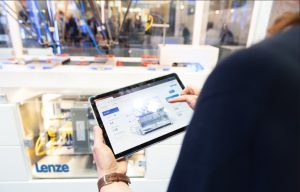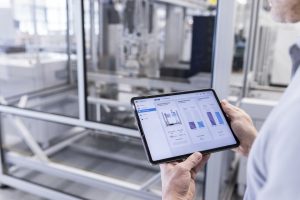 There has been a significant move to invest in IIoT technologies in machines over recent years, as the sector continues its Industry 4.0 journey. As end users seek to improve the output of their machines and look to achieve digital transformation, there is a significant opportunity for OEMs willing to bridge the analogue-to-digital gap. Here Wouter Meijers at Lenze, a leading provider of machine automation solutions, discusses the benefits of making such a move and the added value that digitisation of a machine’s information and full digitalisation of existing processes can bring.
There has been a significant move to invest in IIoT technologies in machines over recent years, as the sector continues its Industry 4.0 journey. As end users seek to improve the output of their machines and look to achieve digital transformation, there is a significant opportunity for OEMs willing to bridge the analogue-to-digital gap. Here Wouter Meijers at Lenze, a leading provider of machine automation solutions, discusses the benefits of making such a move and the added value that digitisation of a machine’s information and full digitalisation of existing processes can bring.
Customer pain points
Producing more with less has been the driving force behind manufacturing for many years now. Machine builders are wanting solutions that are reliable, quick to build with fewer resources and deliver the increasing flexibility demanded by their customers. The end user customer is wanting machines that will help them reduce costs and deliver results more quickly, all whilst helping run them with a less skilled workforce.
 As companies look to progress on their journey from initial digitalisation to industry 4.0, they need to ensure that their machinery makes the most of the data that is already in existence. To do this, machines need to not only be remotely accessible, but give visibility to what is happening when they are running and why this is happening. They also need to deliver sufficient data to show what is limiting productivity to enable the elimination of these factors and to predict what will happen to the machine in the near future.
As companies look to progress on their journey from initial digitalisation to industry 4.0, they need to ensure that their machinery makes the most of the data that is already in existence. To do this, machines need to not only be remotely accessible, but give visibility to what is happening when they are running and why this is happening. They also need to deliver sufficient data to show what is limiting productivity to enable the elimination of these factors and to predict what will happen to the machine in the near future.
The benefits of digitisation
By exploiting the value of the data that is now more accessible than ever before as well as staying competitive with other machine builders, OEMs can ensure that their companies are fit for the future. Also, the digitisation of a machine’s information and full digitalisation of existing processes presents a range of other business opportunities to OEMs, including adding predictive maintenance and condition monitoring to service contracts and the implementation of business models such as pay-per-use.
 Many machine builders are still unsure about the best software route to choose. However, the journey to digitisation of machine information isn’t as complicated as it might first appear.
Many machine builders are still unsure about the best software route to choose. However, the journey to digitisation of machine information isn’t as complicated as it might first appear.
Getting started
With the majority of existing machines already containing an advanced programmable logic controller (PLC), when combined with HMI-panels, sensors and smart inverter drives the foundations for an intelligently controllable machine are already in place. By using a remote access solution, such as Lenze’s X4 Remote, access can then be achieved to the machine for service and maintenance procedures. Interestingly, the X4 Remote ‘out of the box’ solution has been trialled alongside an OEM also designing their own system and has been found to be significantly quicker and cheaper to get up and running.
 Counting the cost
Counting the cost
When it comes to embracing digitisation of machines, OEMs are faced with either expanding the team to include those with specific and expensive IT skills, or using cost-efficient solutions such as X4 Remote, that simplify the digital transition process. Remote access can reduce costs during commissioning and warranty periods using Lenze’s solution, and by monitoring OEE (Overall Equipment Effectiveness) it is possible to better track and compare the productivity of different machines and remotely check any problems using the x500 hardware. As an additional cost-saving benefit, the X4 Remote solution can be used as a cost-effective but highly effective condition monitoring alternative to installing costly sensors: it can be set up to analyse the harmonics in the current of a motor and initiate early warning alerts if there are any subtle changes.
Tailoring to suit
Using the X4 Remote platform machine builders can create, brand, and easily customise their own IIoT platform. Importantly the app allows device pages to be customised without any significant programming skills or development costs and everything is at hand to adapt the platform to suit their specific machine requirements. Thanks to the promotion of open standards and compatibility between systems, and supporting a broad range of industry standard protocols, the X4 Remote solution offers engineers and operators even greater machine tailoring flexibility. Also, OEMs can connect the solution to existing customer MRP systems, using an API as a connecting device.
Lucrative business models
A machine’s Overall Equipment Effectiveness (OEE) is a key KPI in understanding its output.
The PLC in a machine already has all the relevant data in it, with the addition of software to calculate specific OEE’s and show them in real-time on any pc, smart phone or tablet. Due to solutions such as X4 Remote, the world of predictive maintenance is opened to both the end customers and OEMs alike. OEMs can offer to monitor and alert their customers as to repair and maintenance issues when key indicator alerts are activated, creating a previously untapped revenue stream. As an additional business model some of Lenze’s OEMs are at present considering the implementation of application models such as pay-per-use; the ability to track which machine has been used, for how long and where, the option of renting out machines and offering usage licences has now been opened to OEMs too.
